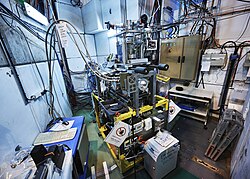| List of ISOLDE experimental setups | |
|---|---|
| COLLAPS, CRIS, EC-SLI, IDS, ISS, ISOLTRAP, LUCRECIA, Miniball, MIRACLS, SEC, VITO, WISArD | |
| Other facilities | |
| MEDICIS | Medical Isotopes Collected from ISOLDE |
| 508 | Solid State Physics Laboratory |

The Emission Channeling with Short-Lived Isotopes (EC-SLI) experiment is a permanent setup located within the ISOLDE facility and CERN. The purpose of the experiment is to study lattice locations of dopants and impurities in both single crystals and epitaxial thin films. The experiment uses short-lived isotopes from the ISOLDE on-line beamline, as well as longer-lived isotopes from three off-line beamlines.
Background
The EC-SLI experiment uses the method of emission channelling (EC) to identify the position of short-lived isotopes in a single crystal lattice. Radioactive isotope probes are introduced into the crystal using ion implantation, and a positron-sensitive detector detects its decay particles. The particles that the isotope emits interact with the electrons and nuclei of the crystal's atoms, and experience channeling and blocking effects on their way out of the crystal.
The yield of the emitted particles is dependent on the position of the detector relative to the crystallographic axes. Therefore, the position of the isotope within the lattice can be determined by taking measurements of electron intensity and comparing them to simulated results. The emission patterns produced are characteristic of the lattice sites occupied by the isotopes, determining its functional properties (i.e. n-type or p-type doping). The benefits of emission channelling include an increase in efficiency by roughly four orders of magnitude and the study of elements lighter than the host atoms used.
Experimental setup

The experimental setup for the EC-SLI experiment is assembled on an adjustable frame structure with three sections: a beam tube and collimation chamber, experimental, and a vacuum block. It is mounted to the GHM beamline at the ISOLDE facility.
The emission channelling measurements take place in a cylindrical-shaped chamber after the samples are implanted and cooled. Upon flanges inserted along the chamber's perimeter, are auxiliary devices including a cryogenic cooler, Faraday cup, view ports and a load lock. Special format flanges mount electron detector cases, links to the vacuum station, a lightening quartz lamp, the thermal shield actuator feedthrough, and goniometers, at various points around the chamber. Two rigidly aligned collimators connect to a beam transport tube, allowing the ISOLDE ion beams to be optimally transported and focused.
Results
The EC-SLI experiment has been successfully involved in determining the lattice locations of short-lived isotopes in a variety of semiconductor materials. The focus of emission channeling experiments at ISOLDE are investigations into lattice locations of transition metal probes, and p-type doping using short-lived alkaline earth probes or long-lived probes.
A current research aim is to continue the characterisation of quantum colour centres in diamond using the emission channeling technique, in order to correlate lattice locations with optical properties.
External links
- EC-SLI page within ISOLDE facility website
- More information on Emission Channelling (created by SSP CERN)
References
- Wahl, Ulrich; Augustyns, Valérie; Correia, João Guilherme; Costa, Ângelo; David Bosne, Eric; Lima, Tiago; Lippertz, Gertjan; Lino, Pereira; Manuel, da Silva; Kritiaan, Temst; Vantomme, André (10 Jan 2017). "Emission channeling with short-lived isotopes (EC-SLI) of acceptor dopants in nitride semiconductors". ISOLDE and Neutron Time-of-Flight Experiments Committee.
- Hofsäss, Hans; Lindner, Gerhard (1991-03-01). "Emission channeling and blocking". Physics Reports. 201 (3): 121–183. Bibcode:1991PhR...201..121H. doi:10.1016/0370-1573(91)90121-2. ISSN 0370-1573.
- Langouche, G.; Soares, J. C.; Stoquert, J. P. (1992-04-01). Nuclear Methods in Semiconductor Physics. Elsevier. ISBN 978-0-444-59681-9.
- O'Donnell, Kevin Peter; Dierolf, Volkmar (2010). Rare earth doped III-nitrides for optoelectronic and spintronic applications. Topics in applied physics. Dordrecht, the Netherlands New York Bristol, UK: Springer in association with Canopus Academic Pub. ISBN 978-90-481-2877-8.
- "EC-SLI | ISOLDE". isolde.cern. Retrieved 2023-07-18.
- ^ Wahl, U.; Correia, J. G.; Costa, A.; David-Bosne, E. (6 December 2013). "Emission Channeling with Short-Lived Isotopes (EC-SLI) at CERN's ISOLDE facility" (PDF). Proceedings of the First International African Symposium on Exotic Nuclei (IASEN 2013).
- ^ Silva, M. R.; Wahl, U.; Correia, J. G.; Amorim, L. M.; Pereira, L. M. C. (18 July 2013). "A versatile apparatus for on-line emission channeling experiments". Rev Sci Instrum. 84 (7): 073506–073506–8. Bibcode:2013RScI...84g3506S. doi:10.1063/1.4813266. PMID 23902062.
- Wahl, U.; Correia, J. G.; Decoster, S.; Pereira, L.; Marques, C. P.; Amorim, L.; da Silva, M.R. "Recent results from electron emission channeling on-line experiments" (PDF). Retrieved 18 July 2023.
- Pereira, L. M. C.; Wahl, U.; Correia, J. G.; Biesmans, B.; Costa, A. R. G.; da Silva, M. R.; David Bosne, E.; Lamelas, A.; Magchiels, G.; Moens, J.; Tunhuma, S. M.; Villarreal, R.; Vantomme, A. (10 Jan 2023). "Quantum colour centers in diamond studied by emission channeling with short-lived isotopes (EC-SLI) and radiotracer photoluminescence" (PDF). Addendum to IS668 to the ISOLDE and Neutron Time-of-Flight Committee.